If you’re contemplating the use of Ozempic, it’s crucial to acquaint yourself with the complete information surrounding it. For instance, how does Ozempic function? And how should it be administered? This article will delve into everything you need to comprehend about Ozempic dosages, including details about the Ozempic savings card and the maximum dosage allowed. We’ll explore:
- The nature of Ozempic and its effect on the body
- Factors influencing your Ozempic dose
- Various methods of Ozempic administration
- The typical dosage of Ozempic
- A guide to understanding Ozempic doses
- Considerations for specific medical conditions
- Actions to take in case of a missed dose or overdose
- Important instructions regarding Ozempic administration
- Potential side effects of your Ozempic dosage
- Frequently asked questions
Ready to dive in? Let’s get started!
What is Ozempic?
Ozempic, an injectable medication approved by Health Canada and marketed by Novo Nordisk. While Ozempic is the marketed name of the drug semaglutide, it may also be found under brand names Wegovy or Rybelus. You may also encounter the brand Trulicity, which is a dulaglutide — similar to semaglutide but not identical.
Semaglutide is a GLP-1 receptor agonist, meaning it replicates the function of this hormone in the body.
How Does Ozempic Work?
Ozempic stimulates insulin production from the pancreas, thereby aiding blood sugar control. This effect on blood sugar levels is a key aspect of how Ozempic helps manage type 2 diabetes.
Studies have discovered that, in addition to providing tools to manage diabetes, Ozempic has significant potential for successfully aiding weight management and reducing the risk of major cardiovascular events. This includes high blood pressure, heart attack, stroke and death.
What Factors Influence Ozempic Dosage?
Several factors affect the Ozempic dosage for a patient. These include the individual’s medical history, blood sugar levels, and the presence of any other diseases or conditions. Body weight can also be a factor.
Drugs that treat diabetes, like insulin and metformin, can particularly affect the dosing schedule and treatment plan, as in combination with Ozempic, it can lead to hypoglycemia. It’s important to discuss any potential problems with your medical team to ensure the best care.
How Can You Administer Ozempic?
Ozempic is available in an injection pen that patients self-administer subcutaneously (i.e., just under the skin). Typical injection sites are the thigh, abdomen, or arm.
It comes in a pre-filled pen available in different strengths (between 0.25 mg–2 mg), which patients are prescribed depending on their requirements. The form of the medication and the tools provided, such as the pen, make it easy for patients to manage their treatment.
Novo Nordisk provides a helpful video detailing how exactly to use your Ozempic Pen. However, if unsure, consult your medical team for further instruction. You can learn more about the Ozempic Pen on the Jill Health website.
What is the Typical Ozempic Dosage?
The dosage of Ozempic varies based on the patient’s condition and how they respond to the drug. However, a typical dosing schedule will likely follow the pattern laid out below.
Month 1
In the first month, the starting dose is usually 0.25 mg, taken once weekly. This initial low dose helps your body get accustomed to the medication while monitoring for any side effects or reactions.
Month 2
In the second month, starting in week 5, the dosage is typically increased to 0.5 mg once weekly. If you require additional control, your medical team may up your dose to 1 mg or 2 mg, at the maximum.
Month 3
The dose remains stable in your third month. The amount that you are prescribed will be your maintenance dose going forward. Your medical team may monitor you for side effects to ensure you are tolerating your dosage.
Month 4 and Beyond
Your dosage will remain the same, with your medical team checking in to make sure the medication is working for you. Ozempic doses don’t continue to increase over time. Once you’ve reached the maintenance dose, you’ll remain on that amount for as long as you are on the medication. It’s important to understand your rights as a patient and to discuss any concerns with your healthcare provider.
A Comprehensive Guide to Ozempic Dosage
Precise dosing and understanding its forms and strengths are crucial in maximizing its benefits, as well as minimizing side effects.
Understanding Ozempic Forms
Ozempic comes in injectable form with pre-filled, easy-to-use dosing pens — similar to an EpiPen. This makes it easy for patients to administer the medication at home, as long as they follow the provided instructions.
The injection is best administered in the abdomen, arm, or thigh, and it is important to rotate injection sites to avoid skin irritation.
What Are Ozempic Strengths?
Ozempic comes in four different strength pens — 0.25 mg, 0.5 mg, 1 mg, and 2 mg. In most cases, patients will start on 0.25 mg per week, maintaining their dose at 0.5 mg. In cases where patients need more support, the maximum dose is 2 mg.
Long-Term Use of Ozempic
Long-term use could entail some risks, such as a potential increase in the risk of thyroid tumors and pancreatitis.
Additionally, if you’re pregnant or planning to conceive, you should discuss this with your medical team.
If you develop any more serious side effects, such as abdominal pain, severe nausea, any symptoms related to heart disease, or allergic reactions, stop your use of Ozempic immediately, and contact your medical team.
In any case, regular check-ups and listening to your medical team’s advice are essential during long-term use.
Are There Specific Dosage Adjustments for Medical Conditions?
Some medical conditions might require adjustments to your Ozempic dosage. These include if the patient has kidney disease, liver disease, or a history of thyroid tumors or pancreatitis.
If the patient is taking other medications, such as insulin or metformin, their Ozempic dosage may also be impacted.
It’s important for the patient to discuss their full medical history with their medical team before deciding to take Ozempic.
What Happens If I Miss a Dose of Ozempic?
If you miss a dose of Ozempic, take it as soon as you remember if within 5 days of the missed dose.
If longer than 5 days, skip the missed dose and administer the next one on your regularly scheduled day.
Never take two doses of Ozempic at the same time to make up for a missed dose.
Consistent dosing is crucial for maintaining stable blood sugar levels, so try to follow your dosing schedule as closely as possible.
What Should I Do If I Overdose on Ozempic?
If you suspect an overdose of Ozempic, seek immediate medical attention. An overdose can result in:
- Severe nausea
- Headache
- Vomiting
- Diarrhea
- Hypoglycemia (low blood sugar).
Severe hypoglycemia can lead to loss of consciousness or even death, so it’s critical to take immediate action. You should also contact your medical team as soon as possible to discuss the events and any potential adjustments to your treatment plan.
Always remember to adhere to the prescribed dosing schedule to prevent overdose and its associated risks.
Important Administration Instructions for Ozempic Dosage
Ozempic is injected once a week just under your skin. The best places to inject are the stomach, thigh, or upper arm, and it is important to rotate your injection site.
Each injection pen is prefilled, which allows for accurate dosage.
Make sure you store the pens according to manufacturer instructions and dispose of the pen properly after using it. Your pharmacist, medical team, or Nurse Practitioner will also be able to advise you on this matter.
Are There Potential Side Effects of Ozempic Dosage?
Like all medications, there is a list of potential side effects when using Ozempic. If you’re considering taking or prescribing Ozempic, it’s important to be aware of all the potential side effects and warnings associated with the drug.
The most common side effects include:
- Nausea
- Constipation
- Vomiting
- Diarrhea
- Abdominal pain.
It is also quite common to have itching, bruising, swelling, and redness at the injection site.
There are some rarer and more serious side effects as well. These include:
- Pancreatitis
- Changing vision
- Kidney problems
- Increased heart rate
- Increased risk of thyroid tumors, including medullary thyroid carcinomas (MTC).
If you experience any of these side effects, stop your Ozempic use immediately, and contact your medical team, or visit the ER at your local hospital right away.
It is always important to inform your medical team of the less severe side effects as well.
For a more comprehensive understanding of the side effects of Ozempic, you can read this article on Cover Health.
Key Takeaways
Ozempic is an effective prescription-only medication. The dosage needs to be personalized based on the individual’s medical history, current health status, and response to treatment.
The medication comes in pre-filled injection pens, making administration straightforward. However, it is essential to follow the correct dosing schedule and administration instructions to ensure effective treatment.
Side effects can occur, and it’s crucial to monitor these and communicate any concerns to your healthcare provider.
Ozempic Dosage FAQs
What is the Ozempic dosage per pen?
Ozempic comes in prefilled injection pens with four different strengths — 0.25 mg, 0.5 mg, 1 mg, and 2 mg. Each pen contains enough medication for four weekly doses.
It’s important to ensure you’re using the correct dosage as prescribed by your medical team. Always use a new needle for injections, never share your Ozempic Pen with others, and follow the instructions provided with your medication to ensure accurate dosing.
Is Ozempic prescribed for weight loss?
While weight loss is not the primary indication for Ozempic, it is a known side effect of the medication.
Ozempic works by mimicking the functions of the body’s natural GLP-1 hormone, which, among other actions, reduces hunger and helps you feel fuller faster. As a result, people on Ozempic often report weight loss.
However, it’s important to remember that any medication should be used as part of a comprehensive health plan that includes a healthy diet and exercise, and you should only aim to lose around two pounds a week (this is considered to be the safest and most sustainable amount).
How can I use Ozempic?
Ozempic is administered as a subcutaneous injection, typically once a week. It’s usually injected into the abdomen, thigh, or arm. You should rotate the injection site each week to minimize the risk of skin reactions.
Before injecting, inspect the solution to ensure it’s clear and free of particles. Attach a new needle to the pen, dial your prescribed dose, and then inject the medication under your skin. Dispose of the needle safely after each use.
Remember, it’s crucial to follow the detailed instructions provided with the medication and consult your medical team if you have any questions about your treatment.






